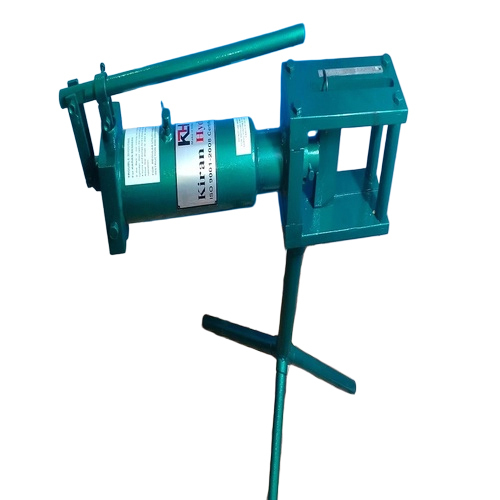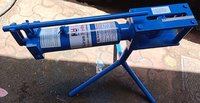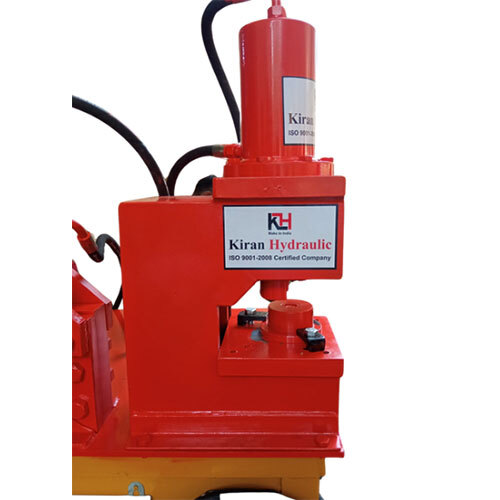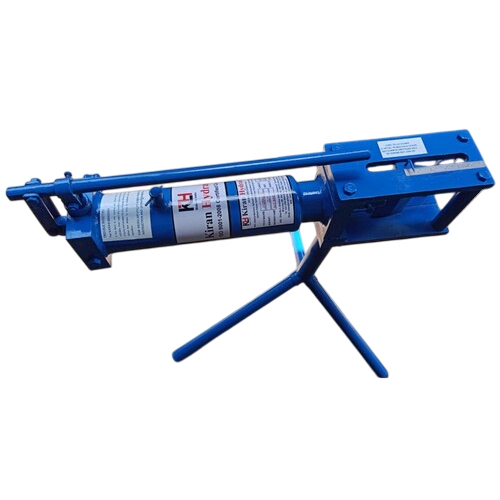An ISO 9001:2008 Certified Company
Hydraulic Busbar Bending Machine
24500.00 INR/Set
Product Details:
- Size 200 MM
- Length 800 Millimeter (mm)
- Weight 35 Kilograms (kg)
- Width 200 Millimeter (mm)
- Product Type HYDRAULIC MACHINE
- Height 700 Millimeter (mm)
- Usage BUS BAR BENDING
- Click to View more
X
Hydraulic Busbar Bending Machine Price And Quantity
- 24500.00 INR/Set
- 1 Piece
- 19500.00 - 35000.00 INR/Set
Hydraulic Busbar Bending Machine Product Specifications
- 200 MM
- Other
- Watt (w)
- 5 MM mm/m
- Hydraulic
- HYDRAULIC MACHINE
- 12 MONTH
- 200 Millimeter (mm)
- 700 Millimeter (mm)
- MS
- BLUE
- Stainless Steel
- BUS BAR BENDING
- 800 Millimeter (mm)
- 35 Kilograms (kg)
Hydraulic Busbar Bending Machine Trade Information
- Telegraphic Transfer (T/T), Cash Advance (CA)
- 6 Piece Per Week
- 2 Days
- If order is confirmed we will reimburse the sample cost
- WOODEN BOX
- Australia, South America, Western Europe, Middle East, Africa, Central America, Asia, Eastern Europe, North America
- All India
- ISO
Product Description
A hydraulic busbar bending machine is a specialized piece of equipment used in electrical and power distribution systems to bend or shape busbars. Busbars are flat strips or bars made of copper or aluminum used to conduct electricity within electrical panels, switchgear, and distribution systems. These busbars need to be bent or shaped to fit specific configurations within these systems.
Hydraulic Busbar Bending Machine Specifications:
1. Automation Grade: Manual
2. Weight: 35 kg
3. Capacity: 15 ton
4. Model Number: khbb150
5. Material: Mild steel
6. Color: Dark green
Here are some key features and information about hydraulic busbar bending machines:
1. Hydraulic Operation: These machines use hydraulic pressure to bend the busbars. Hydraulic systems provide high force and precision, making them suitable for bending thick and rigid busbars.
2. Versatility: Hydraulic busbar bending machines are designed to bend busbars into various shapes and angles, such as L-shapes, U-shapes, and Z-shapes, depending on the requirements of the electrical system.
3. Control Panel: They typically come with a control panel that allows operators to set the desired angle and bend radius. Some machines may also have programmable settings for automation.
4. Safety Features: Safety is a crucial aspect of these machines. They often include safety guards to protect operators from moving parts and hydraulic systems. Emergency stop buttons and safety interlocks are common features.
5. Capacity: The capacity of a hydraulic busbar bending machine can vary significantly, ranging from smaller machines designed for thinner busbars to heavy-duty machines capable of bending thick and wide busbars.
6. Accuracy: Hydraulic machines provide high accuracy and repeatability in bending, ensuring that the busbars meet the required specifications.
7. Ease of Use: Modern hydraulic busbar bending machines are designed for ease of use, with user-friendly interfaces and controls. Some may have touchscreen displays for convenient operation.
8. Maintenance: Regular maintenance is essential to keep these machines in optimal working condition. This includes checking hydraulic fluid levels, inspecting and lubricating moving parts, and ensuring the safety features are functioning correctly.
9. Applications: Hydraulic busbar bending machines are commonly used in the construction and maintenance of electrical panels, switchgear, and power distribution systems in industries such as electrical engineering, power generation, and distribution.
10. Cost: The cost of a hydraulic busbar bending machine can vary based on its size, capacity, and features. Larger, more capable machines tend to be more expensive.
Applications of Hydraulic Busbar Bending Machine:
Hydraulic busbar bending machines have a wide range of applications in industries related to electrical and power distribution systems. These machines are essential for shaping and bending busbars, which are critical components in electrical panels, switchgear, and distribution systems. Here are some common applications of hydraulic busbar bending machines:
1. Electrical Panel Manufacturing: Hydraulic busbar bending machines are extensively used in the production of electrical panels and switchboards. They are used to bend busbars into the required shapes and configurations to fit within the panel enclosures.
2. Power Distribution Systems: These machines are used in the construction and maintenance of power distribution systems, such as substations and power generation facilities. Busbars are often used to connect and distribute electricity within these systems.
3. Transformer Manufacturing: Transformers play a crucial role in power distribution. Busbars are used in transformers, and hydraulic busbar bending machines are employed to shape busbars according to the transformer's design specifications.
4. Switchgear Manufacturing: Switchgear is used to control and protect electrical equipment. Hydraulic busbar bending machines are used in the production of switchgear components, ensuring that busbars are accurately bent and fitted.
5. Control Panel Fabrication: In various industrial applications, control panels are used to manage and control machinery and processes. Hydraulic busbar bending machines are used to create the busbar connections within these control panels.
6. Renewable Energy Systems: In renewable energy systems such as solar and wind power installations, hydraulic busbar bending machines are used to shape busbars for the electrical connections between panels, inverters, and other components.
7. Shipbuilding: Hydraulic busbar bending machines find applications in the shipbuilding industry for creating custom electrical distribution systems on ships and vessels.
8. Railway and Transportation: In the railway and transportation sector, busbars are used in the electrical systems of trains, trams, and other vehicles. Hydraulic busbar bending machines help customize these busbars to fit specific vehicle designs.
9. Data Centers: Data centers require precise electrical connections and distribution. Hydraulic busbar bending machines are used to create busbar assemblies for data center power distribution units (PDUs) and switchgear.
10. Custom Electrical Installations: In situations where standard electrical components may not fit, hydraulic busbar bending machines are used to create custom busbar configurations to accommodate specific installation requirements.
11. Electrical Maintenance and Repairs: Hydraulic busbar bending machines are valuable tools for repairing and replacing busbars in existing electrical systems. They ensure that the replacement busbars match the original specifications.
FAQ:
1. What is a hydraulic busbar bending machine?
Ans: A hydraulic busbar bending machine is a specialized piece of equipment used to bend and shape busbars, which are flat strips or bars made of copper or aluminum used to conduct electricity in electrical panels, switchgear, and distribution systems.
2. How does a hydraulic busbar bending machine work?
Ans: These machines use hydraulic pressure to exert force on the busbar, causing it to bend into the desired shape. Hydraulic systems provide high force and precision for bending busbars accurately.
3. What types of busbars can be bent using a hydraulic busbar bending machine?
Ans: Hydraulic busbar bending machines can bend various types of busbars, including copper and aluminum, in different sizes and thicknesses to meet specific application requirements.
4. What are the common shapes and angles that can be created with these machines?
Ans: Hydraulic busbar bending machines can create various shapes and angles, including L-shapes, U-shapes, Z-shapes, and custom configurations as needed for electrical panel and distribution system layouts.
5. What safety features are typically found on these machines?
Ans: Safety features often include safety guards to protect operators from moving parts, emergency stop buttons, safety interlocks, and overload protection to ensure safe operation.
6. Are hydraulic busbar bending machines easy to operate?
Ans: Modern hydraulic busbar bending machines are designed for ease of use, often featuring user-friendly interfaces and controls. Some models may even have touchscreen displays for convenient operation.
7. What industries use hydraulic busbar bending machines?
Ans: Industries such as electrical engineering, power generation, power distribution, transformer manufacturing, control panel fabrication, renewable energy systems, shipbuilding, data centers, and transportation (e.g., railway) commonly use hydraulic busbar bending machines.
8. Can these machines handle different busbar sizes and thicknesses?
Ans: Yes, hydraulic busbar bending machines come in various sizes and capacities to handle a wide range of busbar sizes and thicknesses, from thin strips to thick and rigid bars.
9. How do I maintain a hydraulic busbar bending machine?
Ans: Regular maintenance is essential to ensure the machine's optimal performance. Maintenance tasks typically include checking hydraulic fluid levels, inspecting and lubricating moving parts, and verifying that safety features are functioning correctly.
10. What is the cost of a hydraulic busbar bending machine?
Ans: The cost can vary significantly based on factors such as the machine's size, capacity, features, and brand. Smaller, less capable machines may be more affordable, while heavy-duty models with advanced features can be more expensive.
11. Can these machines be used for bending other materials besides busbars?
Ans: While hydraulic busbar bending machines are specifically designed for bending busbars, they may have limited adaptability for bending other flat or thin materials, depending on their design and capabilities.
12. Is training required to operate a hydraulic busbar bending machine?
Ans: Yes, operators should receive proper training to ensure safe and effective operation of these machines. Understanding the machine's controls, safety features, and best practices is crucial to prevent accidents and produce accurate bends.
13. Can hydraulic busbar bending machines be automated?
Ans: Some hydraulic busbar bending machines come with programmable settings and automation features, allowing for precise and repeatable bending operations. These automated features can improve efficiency in high-volume production environments.
Tell us about your requirement

Price:
Quantity
Select Unit
- 50
- 100
- 200
- 250
- 500
- 1000+
Additional detail
Mobile number
Email











